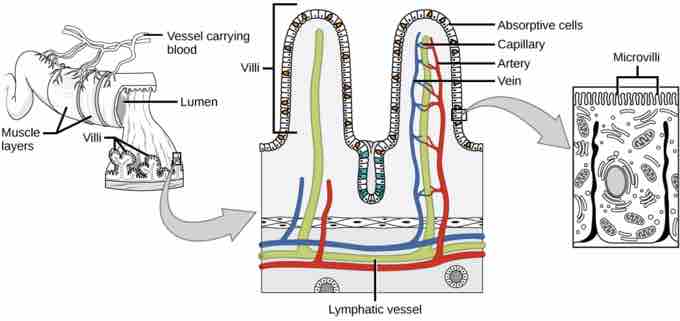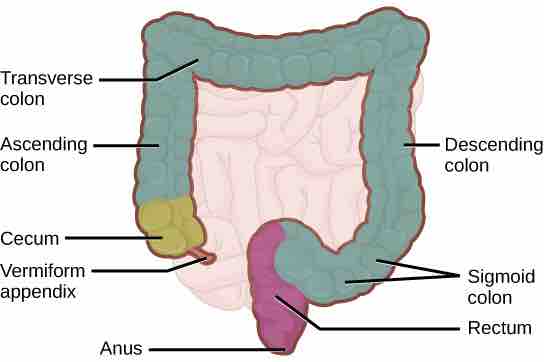Parts of the Digestive System
The vertebrate digestive system is designed to facilitate the transformation of food matter into the nutrient components that sustain organisms. The lower gastrointestinal tract includes the small and large intestines, rectum, anus, and accessory organs.
Small Intestine
Chyme moves from the stomach to the small intestine: the organ where the digestion of protein, fats, and carbohydrates is completed. The small intestine is a long tube-like organ with a highly-folded surface containing finger-like projections: the villi. The apical surface of each villus has many microscopic projections: the microvilli. These structures are lined with epithelial cells on the luminal side to allow the nutrients from the digested food to be absorbed into the blood stream on the other side . The villi and microvilli, with their many folds, increase the surface area of the intestine and increase absorption efficiency of the nutrients.

Villi of the small intestine
Villi are folds on the small intestine lining that increase the surface area to facilitate the absorption of nutrients.
The human small intestine, over 6 m long, is divided into three parts: the duodenum, the jejunum, and the ileum. The "C-shaped," fixed part of the small intestine, the duodenum, is separated from the stomach by the pyloric sphincter which opens to allow chyme to move from the stomach to the duodenum where it mixes with pancreatic juices. The alkaline solution is rich in bicarbonate that neutralizes the acidity of chyme and acts as a buffer. Digestive juices from the pancreas, liver, and gallbladder, as well as from gland cells of the intestinal wall itself, enter the duodenum. Absorption of fatty acids also takes place in there.
The second part of the small intestine is called the jejunum. Here, hydrolysis of nutrients is continued while most of the carbohydrates and amino acids are absorbed through the intestinal lining. The bulk of chemical digestion and nutrient absorption occurs in the jejunum.
The ileum is the last part of the small intestine. It is here that bile salts and vitamins are absorbed into blood stream. The undigested food is sent from the ileum to the colon through the ileocecal valve via peristaltic movements of the muscle. The vermiform, "worm-like," appendix is located at the ileocecal valve. The appendix of humans secretes no enzymes and has an insignificant role in immunity.
Large Intestine
The large intestine reabsorbs water from undigested food material and processes waste material; although it is also capable of absorbing vitamins that are synthesized by the normal microflora housed herein. The human large intestine is much smaller in length than the small intestine, but larger in diameter. It has three parts: the cecum, the colon, and the rectum. The cecum joins the ileum to the colon. It is the receiving pouch for the waste matter. The colon, home to many bacteria or "intestinal flora" that aid in the digestive processes, can be divided into four regions: the ascending colon, the transverse colon, the descending colon, and the sigmoid colon. The main functions of the colon are to extract the water and mineral salts from undigested food and to store waste material. Due to their diet, carnivorous mammals have a shorter large intestine compared to herbivorous mammals.

Large intestine
The large intestine reabsorbs water from undigested food and stores waste material until it is eliminated.
Rectum and Anus
The rectum is the terminal end of the large intestine. Its primary role is to store the feces until defecation. The feces are propelled using peristaltic movements during elimination. The anus, an opening at the far-end of the digestive tract, is the exit point for the waste material. Two sphincters between the rectum and anus control elimination: the inner sphincter is involuntary, while the outer sphincter is voluntary.
Accessory Organs
The organs discussed above are those of the digestive tract through which food passes. Accessory organs are those that add secretions (enzymes) that catabolize food into nutrients. Accessory organs include salivary glands, the liver, the pancreas, and the gallbladder. The liver, pancreas, and gallbladder are regulated by hormones in response to the food consumed.
The liver, the largest internal organ in humans, plays a very important role in digestion of fats and detoxifying blood. It produces bile: a digestive juice that is required for the breakdown of fatty components of the food in the duodenum. The liver also processes the vitamins and fats along with synthesizing many plasma proteins.
The pancreas is another important gland that secretes digestive juices. The chyme produced from the stomach is highly acidic in nature; the pancreatic juices contain high levels of bicarbonate, an alkali that neutralizes the acidic chyme. Additionally, the pancreatic juices contain a large variety of enzymes that are required for the digestion of protein and carbohydrates.
The gallbladder, a small organ, aids the liver by storing bile and concentrating bile salts. When chyme containing fatty acids enters the duodenum, the bile is secreted from the gallbladder into the duodenum.